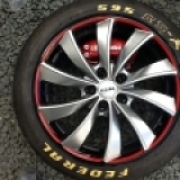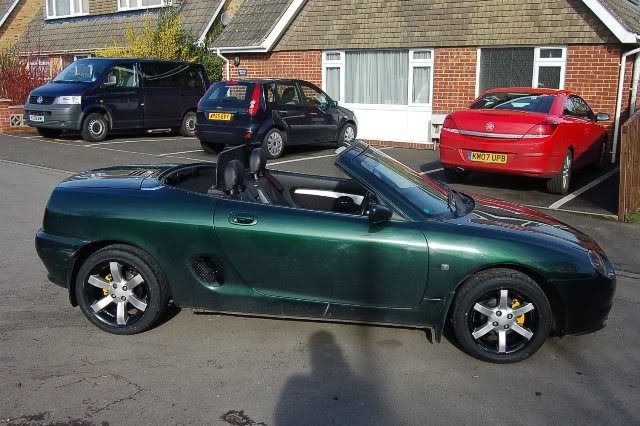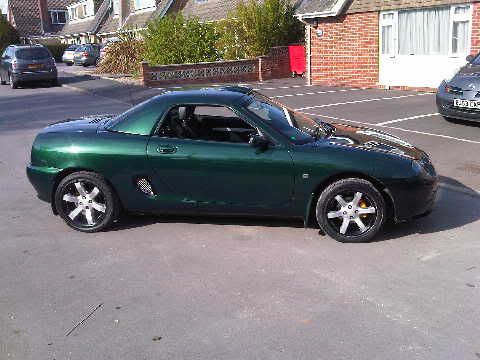Sports cars.... bigger wheels, wide low profile tyres, must be the best option, yes?. It is if your car was designed with them in mind. Retro fitting them to a car not originally designed for them can reduce performance, adversely effect stability, handling and can prove to be dangerous.
With the trend for cars to be fitted with larger alloy wheels as standard, which do generally look better, it is very tempting to go down the path of fitting larger wheels to your car. This can however lead to a number of problems.
Warning this next bit needs some time and consideration, leave now if you CBA.

Many of our overseas members, including Germany, Belgium and Australia often comment with some surprise at the freedom to modify we have in this country. In many countries the law says you cannot change overall diameter from original equipment specification. So why do they impose these restrictions?
This extract from a Sumitomo Tyre service bulletin gives a very simplified overview of just a few things people need to consider if thinking of going down the route of larger wheels (Plus sizing);
" To avoid re-engineering the vehicle one must stay within the load carrying capacity requirements, speed-rating requirements, O. D. (or revolutions per mile) tolerances, and weight standards established by the vehicle manufacturer. Other considerations may be necessary if the vehicle is equipped with Tire Pressure Monitoring systems.
Plus sizing may affect vehicle handling in several ways. The effects of higher lateral traction, or quicker steering response, may affect stability issues on dry roads. Also, Plus Sizing may affect vehicle handling, such as drivability in decreased traction conditions (example: wet or snowy roads).
Failure to consider the issues and follow safe guidelines may increase the dangers of reduced stability due to changes in handling, reduced hydroplaning resistance, reduced snow traction, or tire failures from overloading or underinflation.
When considering a plus size application for a vehicle, parameters include the Original Equipment Tire Size, Speed Rating, Load Capability, Inflation Pressures, Outside Diameter (Overall Tire Diameter), and Revolutions Per Mile, as well as the space limitations of the vehicle wheel well. The plus size changeover may be for looks or for performance enhancements. In either case, lower profile tires which have wider section widths, as well as higher performance tires, normally will increase steering response and overall cornering grip since the tire footprint shape (contact patch) is usually wider and shorter than the Original Equipment tire’s contact patch. To ensure proper vehicle operation the following guidelines may be considered in relation to the original equipment tire and wheel package: Overall Diameter–Within 2% of the original equipment fitment; Optimal is within 1% and usually the shorter is better for stability, turning, acceleration, and braking.
Load and Inflation–Ensure the load carrying capacity for the vehicle is not reduced with the new tires and wheels. Calculate the new minimum inflation pressure to maintain the load equal to or greater than the Original Equipment tire and inform the consumer of the adjusted minimum inflation pressures.
Speed Rating–Using equal or higher speed rated tires ensures the durability standards and performance characteristics are not diminished.
Rim Width and Offset–Ensure the rim width is within the rim range for the selected tire size. Also maintain the offset of the original equipment tire and wheel package.
Tire and Wheel Weight–The combined weight of the new tire and wheel package should be near the Original Equipment weight. Increased weight affects the Shocks, Springs, and Brakes as well as other suspension components.
Clearance
Since Plus Sized Tires and Wheels are usually wider than original, consideration must be given to wheel well space and any potential interference with suspension, chassis, or
bodywork. The new tire and wheel package must have ample clearance to avoid the
possibility of contacting another component of the vehicle through turns, dips, and bumps. Tire deflection, lock-to-lock steering, jounce, and rebound all must be considered.
Brakes
Concern for increased weight of the wheel and tire package must focus on the performance range of the braking system. As the rim diameter increases and the tire widths increase, the weight is concentrated farther out on the lever arm in a rotational mass, which increases the stress on the brakes (or decreases their effectiveness). Also of concern is the overall weight of the tire and wheel and the effect on the braking system. Consideration must be given to upgrading the braking system to maintain braking capability within operational limits.
Electronics
Since the ABS systems, ECS systems, engine management systems, speedometer,
odometer, transmission shift points, speed control system, and inflation warning systems use information based on the revolutions per mile of the tire, attention must be given to maintaining a tire RPM close to the original design. Staying within 1% is optimal. Vehicle dealers should be contacted to reset the electronic codes for affected electronics. Of special concern is any tire inflation warning system that may need recalibrating after a Plus Application. Air pressure is critical for optimum tire performance and tire safety.
Clearance for the monitors within the tire cavity may also be of concern. As the air cavity
reduces in height, the clearance to the monitors may be reduced and therefore may be more vulnerable to road impact damage, as well as damage during tire installation.
Location
(distance from the hub) may or may not affect the monitors’ performance. Contact the
vehicle manufacturer for clarification.
Alignment
Since the shape of the tire footprint has been altered (normally shorter and wider than OE) there may be a need to modify or restrict the range of the static wheel alignment within the factory specifications. When plus sizing be aware that the new tire’s footprint shape may require an alignment arrangement which minimizes scrub and/or camber thrust."
If you want to check how different sized tyres compare you can use one of the many online checkers.
Click here to view one I have used before..
For more a more in-depth, analytical paper on this topic click on the link for the attached document below.









